Fall birding in Gambell, Alaska
By Anne Hoff
Sitting on a plastic mat on a pebble beach, the wind blowing at 30 miles per hour from the north, I join a line of thirty warmly bundled birders watching the wild Bering Sea. A slight windbreak is provided by the line of all-terrain vehicles along the flat ridge of the beach behind us. Though the temp is 40 Fahrenheit, it’s cold!
Thus begins a birding day at the Siberian Yupik village of Gambell on the Northwest Cape of treeless St. Lawrence Island, Alaska. The population of 680 native residents swells for a few weeks from mid-May to June and from mid-August to October each year by up to 50 non-islanders who seek a view of birds found nowhere else in North America, as well as surprise Asian vagrants that draw big-list birders.
Part of the Bering Land Bridge during the last Ice Age, St. Lawrence Island is about 20 miles by 100 miles. It now lies 45 miles off the coast of the Chukotsk Peninsula of Siberia and 195 miles WNW of Nome. (You truly can see Russia while doing a sea watch!)
I travelled there as part of a ten-person, 11-day tour with Wilderness Birding Adventures. We flew to Nome and then transferred to a 12-seat plane for the flight to Gambell. Luckily, all of our food — omitted from our flight due to weight limitations — arrived on the next flight.
When the tiny plane door opened, tour guide Aaron Lang looked in and said, “Are you Anne?” It turns out that I was the only newbie to this company and one of only two new to the island. Aaron knew everyone else on the tour and most of them knew several others. I discovered that Gambell birding etiquette required that everyone who wanted to see a bird sighted by anyone in any group on the island be summoned by radio while the finder “sat on” the bird and held off photographers who risked flushing the bird while others raced to the site. This fits the definition of “chasing birds.”
Aaron’s first announcement was, “There’s a Gray-tailed Tattler just reported from along the lake just down the airstrip, so instead of going to the house first, we’ll head down to find it.” We left our luggage on the tarmac (no terminal) and climbed aboard the “birder’s bus”, a two-wheeled open-air cart holding six passengers pulled behind an ATV (also known as “four-wheeler”). After a brief interruption caused by one of our party falling off a different four-wheeler and being taken to the village clinic to have his head stitched, we motored downwind to view my trip lifer #1.
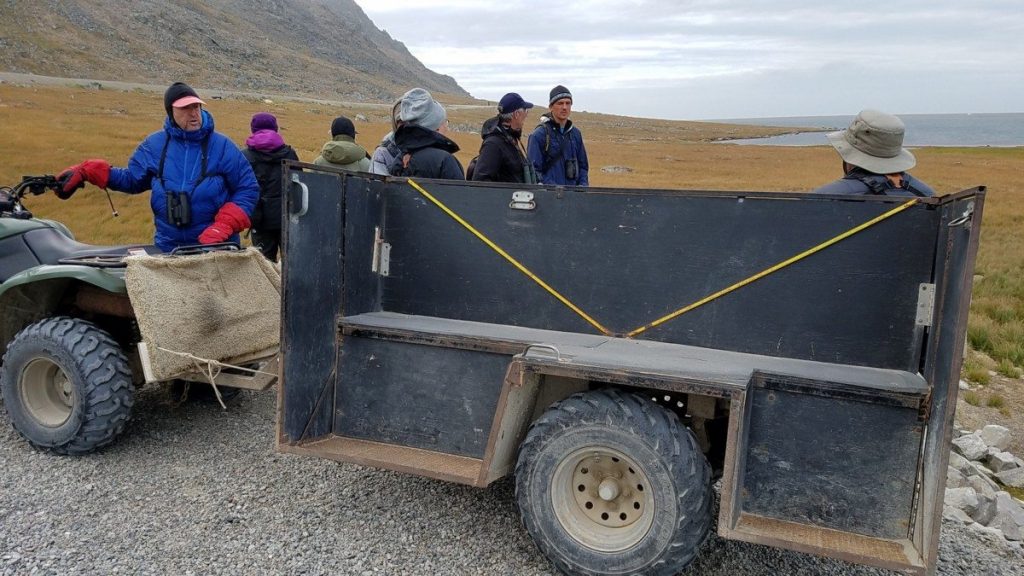
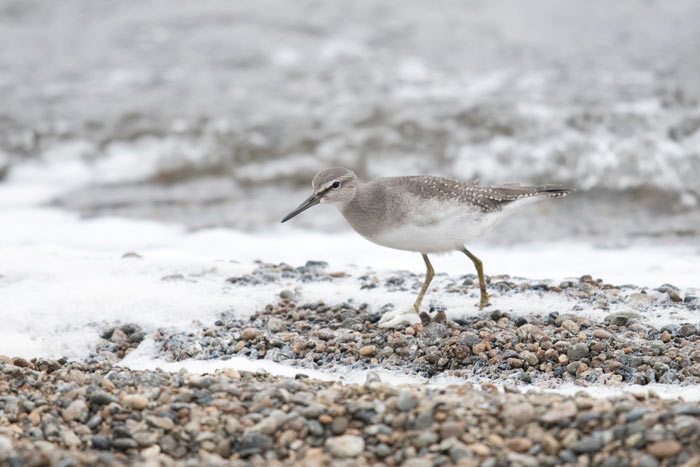
Later — luggage dropped at the house and two layers of clothing added — the bus left for “the far boneyard.” Speeding along the hard-packed road, we passed the post office, the clinic, the K-12 school, and the three modern windmills, and then drove along the boneyard. These areas of the island are middens of varying ages where bones and tusks of arctic animals, sometimes old enough to be partially mineralized, are buried. Village carvers dig holes looking for raw material for their beautiful artistic efforts. These open areas of dirt, surrounded by mounds of removed soil covered with “wormwood” (an Artemisia) have many discarded bones and also provide shelter for vagrant passerines. From the bus I saw a small bird backed into a niche. “STOP!” I called. “Are there supposed to be birds in these holes?” “Probably a wagtail or a Snow Bunting,” the leader said. “I don’t think so.…”
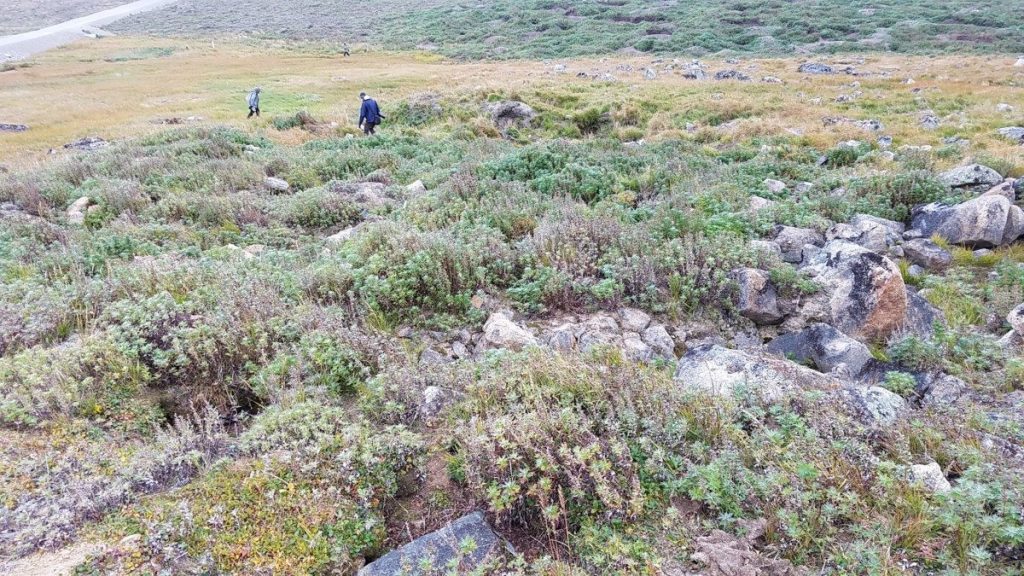
We walked back to my hole and found a juvenile Least Auklet. (Trip lifer #2!)
Three species of auklet nest among the rocks of the village mountain, Sevoukuk, elevation 614 ft. As the young fledge, they must launch themselves from the high-rocks to flutter-glide to the ocean. Unlike Common Murres, no parent awaits and the chick must catch the wind from the cliffs as the sea isn’t a vertical drop from the nest. Some of them don’t quite make it. A moment after my auklet find, Gambell bird guru Paul Lehman motored up and volunteered to rescue the tiny bird. It needed to go to the ocean, and off he went to make the life-saving delivery.
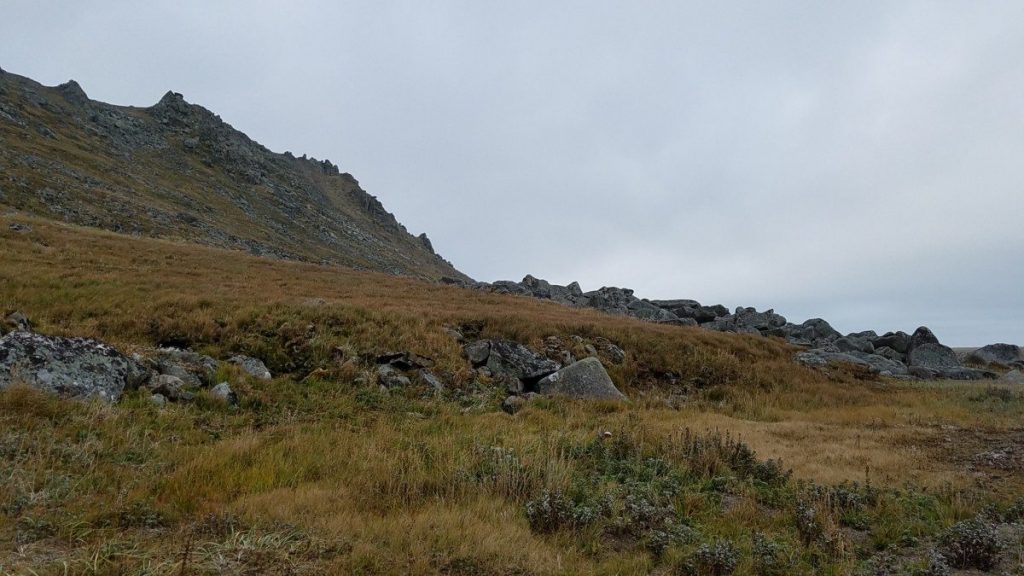
The following day I caught another auklet that fled to the ground from a puddle, still far from the beach. It ran and fell, blew sideways, ran, blew again before I cupped it in my mittened hands. One of the guides walked it out to the surf and watched it swim away. In the following days, this repeated twice more with two Crested Auklet juveniles. The rookery mountain is also the burial ground for the village, with simple plywood coffins among the rocks; there is not enough soil to dig graves because of the permafrost.
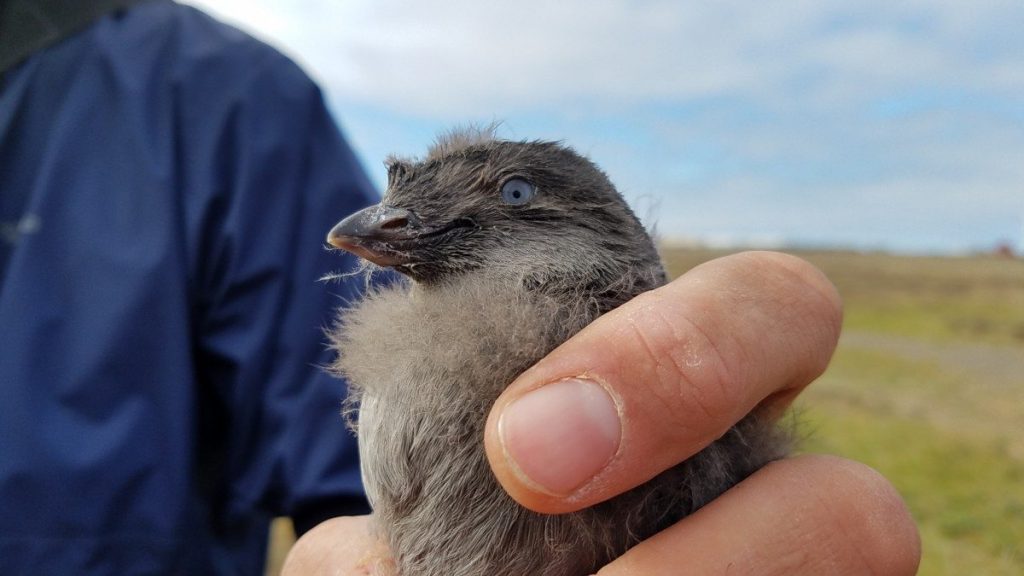
By the end of the day, which included an evening sea watch, my life list was up by five species, including Short-tailed Shearwater, Crested Auklet and Parakeet Auklet. These five were “low-hanging fruit” and were new only to me.
After the next morning’s sea watch, all birders in Gambell headed to the far boneyard for the daily 10:30 a.m. sweep. Birders form a loose line across the edge of the boneyard and proceed across the mounds and around the pits hoping to flush any passerine taking shelter in the pits, re-find the bird, and then identify it. (So much for ethically not disturbing the exhausted bird!)
The reason for waiting until 10:30 is to let the newly-arrived migrants “settle in” and not fly far away when flushed. These boneyard walks were my least favorite activity of the trip. With foot-tall bushy wormwood covering all but the larger dugout pits, the footing is treacherous. Smaller holes create hidden traps. Hidden overhanging edges that have been excavated underneath would collapse when stepped on, dropping you a couple of feet to a bone-jarring landing that endangered every joint in your body.
On Day Three, just after dinner, the radio sputtered “Ancient Murrelet on the water off the tip of the Cape.” As I was the only one who needed the bird as a lifer, Aaron unhitched the bus and I climbed onto the four-wheeler behind him. When not towing, the ATV can go on the pebbles carpeting the entire village and isn’t limited to the road. Although the distance was short, I wouldn’t recommend that ride right after dinner! The reported murrelet was gone. By a great stroke of luck, three more flew by and Aaron pointed them out. Lifer # 8! (Numbers 6 and 7 were White Wagtail, seen nearly daily, and Rock Sandpiper.)
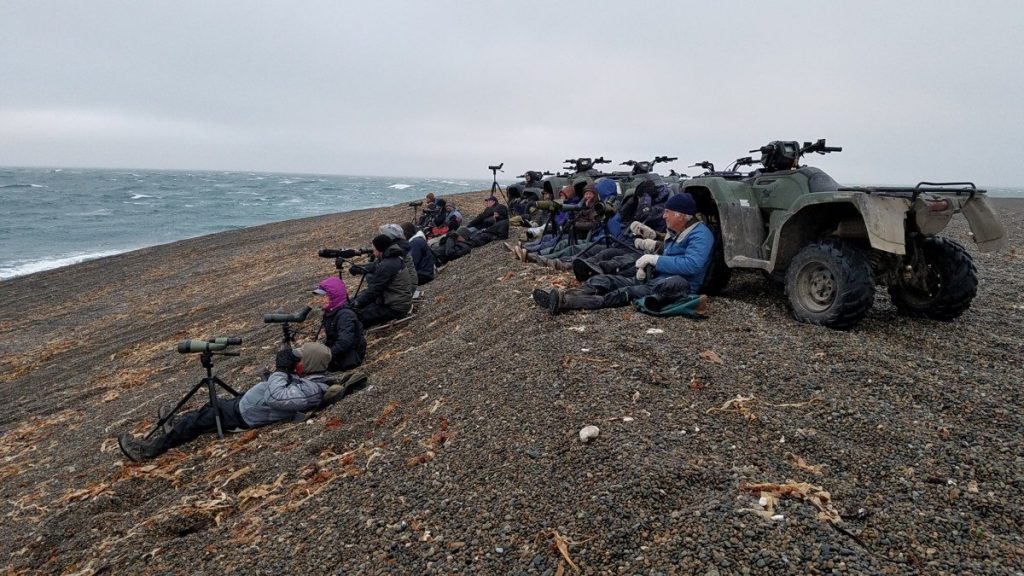
On Day Four, after our daily sea watch and boneyard sweep, a Sharp-tailed Sandpiper was located in the “corner marsh,” across the road from the far boneyard. The freshwater marsh, which borders Troutman Lake, is really a bog that could quickly swallow up a foot and leg in the muck. It was the best baptism for my new Neos, a type of modern galoshes that I wore daily and highly recommend. The sandpiper was skulky but beautiful, a juvenile with rusty cap and delicately edged feathers (Lifer #9).
We had just arrived at the house at the end of the afternoon when again the radio crackled, “Slaty-backed Gull at the North Cape!”
Re-dressing for the outside involved turtleneck over T-shirt and long underwear, Golden Gate Bird Alliance fleece vest, raincoat, balaclava, and jeans over long underwear, topped with rain/wind pants. Plus liner socks, smartwool socks, hiking boots, Neos, polyester gloves and fingerless mitten-gloves with flaps overtop. Think kid in a snowsuit. Nonetheless, we unhitched the bus again and Aaron, Steve the gull-guru participant from Alaska, and I sped to the Point.
Birders already there waved us to the side where we wouldn’t flush the gulls. There were two Slaty-backed Gulls, both second cycle, and well-seen as they stood at the edge of the sea in the 30 mph winds with a few Black-legged Kittywakes and Glaucous and Herring Gulls. Seeing these birds in a group of 20 gulls instead of looking for them among thousands (Half Moon Bay anyone?) was a treat, and that was trip lifer #10.
Day Five was more uncomfortable outside, with 35-40 mph winds. Nonetheless, we hiked and rode along the east shore of Troutman Lake. While looking at two Horned Larks said to be visiting subspecies from Russia, another birder reported an Emperor Goose at the furthest small lake south, about two miles away, at the outer edge of our “land crossing permit” (issued by the Native Corporation).
Luckily — since the other tour participants needed the bus and again I was the only one who had never seen the goose — a birder from Anchorage took me out on his ATV. The goose wasn’t very close, but stood alone in lovely greenery at the far edge of the pond. It was an exquisite adult, with cleanly demarcated white face, black neck and gray back and wings. (Lifer #11.) I later learned that my volunteer driver was the former Undersecretary of the Interior for Alaska!
Later, the radio called again, “Siberian Accentor, in the far boneyard!” We piled on the bus and joined the sweep, which eventually flushed two crisp accentors with orange and black faces and a peachy blush on their throats and breasts, softened and brightened in the late afternoon sun. They were the most cooperative pair of passerines of the trip (compared to the numerous flighty Snow Buntings and Lapland Longspurs). We watched them at the bottom of the mountainside for about 30 minutes. These last two lifers were my favorites of the trip.

Day Six dawned with winds 35-40 mph and gusts to 45. After the seawatch, I declared it a day of rest and spent it indoors with a radio at hand just in case. Our rented house’s owner, Shirley, came over from her son’s house next door to use her oven, and I napped, read, wrote, did crossword puzzles, and hung out with the house dog, Grizzly.
Day Seven was similar, both in weather and activities. In the evening, as the wind abated, I went with our group to sweep the “near boneyard” and “the boatyard,” the areas of the village closest to the ocean. The boneyard holds the skeletons of old boats used for whale and walrus hunts back when the boat was formed by walrus skin stretched around a wooden frame. The other skeletons above ground were the unusable parts of two seasons of bowhead whales — jawbones and ribs, with blackened, dessicated, sinuous flesh hanging off them. Although I’ve seen whale skeletons suspended in a museum, being next to them in the field was a very different experience.
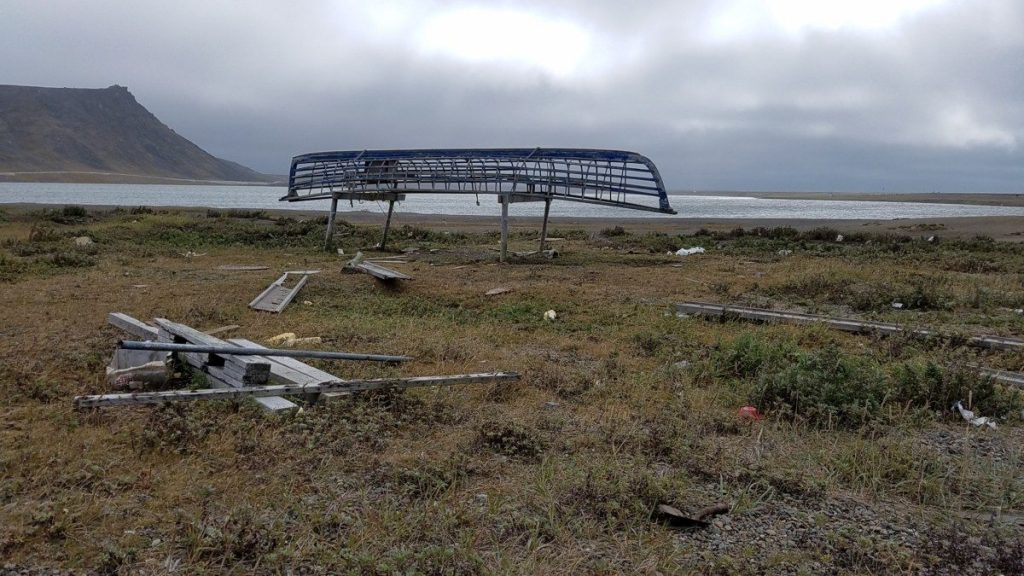
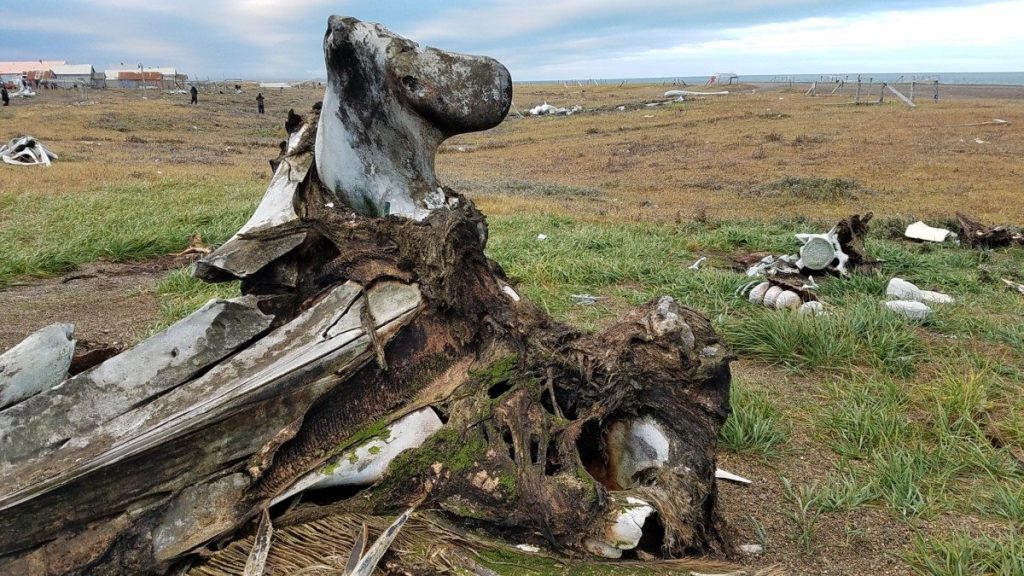
On Day Eight the wind died and switched to west – the direction likely to bring Eurasian vagrants. This much-anticipated change spurred energetic searches in all the migrant traps of the area. Gambell has fifteen first North-America-sighting records, eight in spring and seven in fall. Birders who had come to the island many times were psyched. But besides the expected Bluethroat and Gray-cheeked Thrush, no vagrants were found.
Nor on Day Nine, nor on Day Ten, nor on Day Eleven.
Of course, I was very happy with my 12 trip lifers. Others, who saw no lifers, were resigned and philosophical. Many would return despite (and because of?) the outcome. Would I go back? If I did, it would be in spring migration. But someone else would have to pay for it. There are too many places I’ve never been to do repeats. If it’s a free ride, I’ll take it!
Reference: Lehman, Paul, The Birds of Gambell and St. Lawrence Island, Alaska. Draft available from the author by emailing him: lehman.paul@verizon.net
Anne Hoff has been birding since 1998. A graduate of Golden Gate Bird Alliance’s Master Birding class, she teaches the GGBA Beginning Birdwatching classes and enjoys travelling far and wide to see birds. Her ABA life list stands at about 670.
